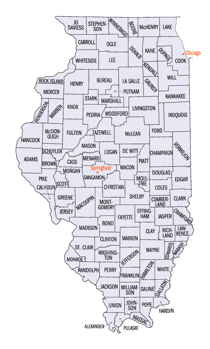Illinois Counties
There are one hundred and two counties in Illinois. St. Clair County was the first county established in what is today Illinois. Most counties in Illinois were named after early American leaders, especially of the American Revolutionary War, as well as soldiers from the Battle of Tippecanoe and the War of 1812.Champaign County, Illinois
Champaign County Education, Geography, and History
Champaign County is a county located in the state of Illinois. Based on the 2010 census, the
population was 201,081. The county is the 10th-most
populous county in Illinois. Champaign County was created
on February 20, 1833. The county seat is Urbana.
This county is named for Champaign County, Ohio, which
took its name from the French for "open level country".
Champaign County is part of the Champaign-Urbana, IL Metropolitan Statistical Area. The twin cities of Urbana and Champaign are the only
cities in the county and they nearly surround the campus of the University of Illinois at Urbana-Champaign.
Etymology - Origin of Champaign County Name
The County was named for Champaign County in Ohio through the influence of emigrants from that county.
Demographics:
County QuickFacts: CensusBureau Quick Facts
Champaign County History
Champaign County was created on February 20, 1833 (Laws, 1833, p. 28) and was formed from Vermilion County. Present area, or parts of it, formerly included in: Vermilion County (1826-1833), Edgar County (1823-1826), Clark County (1819-1823), Crawford County (1816-1819), Edwards County (1815-1816), Madison County (1812-1813), St. Clair County (1801-1812) and Knox, Northwest Territory (1790-1801). The County was named for Champaign County in Ohio through the influence of emigrants from that county. The County Seat is Urbana (1833-Present).
Champaign County, Illinois is located in the heart of East Central Illinois, at Latitude 40.14030 North, Longitude 88.19610 West. US Interstates 57, 72 & 74 intersect in the County which puts Champaign County approximately 2 hours south of Chicago Illinois; 3 hours north-northeast of St. Louis, Missouri; and 2 hours west of Indianapolis, Indiana.
Geography: Land and Water
As reported by the Census Bureau, the county has a total area of 998 square miles (2,584 km2), of which 997
square miles (2,582 km2) is land and 1 square mile (2 km2) (0.07%) is water.
Champaign county is located close to the center of Illinois. The
land is flat, and the soil rich. The county lies in the heart of what was once called the
"Grand Prairie". Workable seams of bituminous coal underlie the surface, but overlying quick sands interfere with
their operation. The Sangamon and Kaskaskia Rivers have their sources in this region, and several railroads cross
the county. The soil is a black muck under laid by a yellow clay. Urbana (with a population of 5,708 in 1900) is the
county seat. Other important points in the county are Champaign (9,000), Tolono (1,000), and Rantoul (1,200).
Champaign and Urbana adjoin each other, and the grounds of the Illinois State University extend into each
corporation, being largely situated in Champaign. Large drifted masses of Niagara limestone are found, interspersed
with coal measure limestone and sandstone. Alternating beds of clay, gravel and quicksand of the drift formation are
found beneath the subsoil to the depth of 150 to 300 feet.
Neighboring Counties
Bordering counties are as follows:
- North: Ford County
- East: Vermilion County
- Southeast: Edgar County
- South: Douglas County
- Southwest: Piatt County
- Northwest: McLean County







